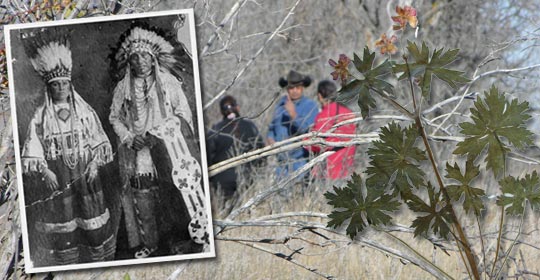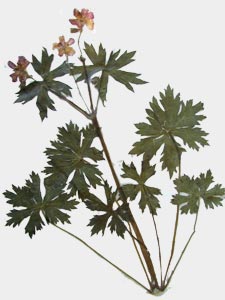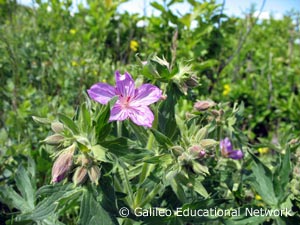Sticky Geranium – Geranium viscosissimum Fisch. & C.A. Mey. ex C.A. (Cranes bill)

The beading on these costumes may represent Sticky Geranium.
Elder Pete Standing Alone telling a story.
(Photo courtesy of Glenbow Museum Archives NA-3284-1(
Sticky Geranium

Geranium viscosissimum Fisch. & C.A. Mey. ex C.A.
Galileo Educational Network
Sticky Geranium is a hairy and sticky plant that grows 30-60 cm tall in the moist areas of our open prairie and on south-facing slopes in the woodlands. The flowers in this area are a deep lavender pink, 3-4 cm across, and have five petals. They bloom in June to July. The leaves look like little palms. They are medium green and about 4-10 cm wide.
You can use the leaves of the Purple Sticky Geranium for a medicine for colds. First boil up the leaves, put a towel over your head and then breathe in the steam. After the liquid has cooled, you can drink it as a medicine. If you have a headache, you can try the same thing. A weak cool tea of leaves can be used for sore eyes.
Our elders kept the leaves in food storage bags to them smell fresh and keep food from spoiling.
Géranium visqueux

Geranium viscosissimum Fisch. & C.A. Mey. ex C.A.
Galileo Educational Network
Le géranium visqueux est une plante velue et collante qui mesure de 30 à 60 centimètres de haut. Il pousse dans notre prairie ou sur le versant sud des boisés. Dans cette région, les fleurs sont d’un rose lavande foncé, mesurant de 3 à 4 centimètres de diamètre. Elles ont cinq pétales et sortent en juin et en juillet. Ses feuilles ressemblent à de petits palmiers. Elles sont d’un vert moyen et mesurent de 4 à 10 centimètres de large.
Les feuilles du géranium visqueux permettent de guérir le rhume. D’abord, il faut faire bouillir les feuilles, se mettre une serviette sur la tête et en respirer la vapeur. Une fois le liquide refroidi, nous pouvons le boire comme remède. En cas de mal de tête, nous pouvons faire la même chose. Le thé faible refroidi fait à partir de ses feuilles peut soulager les maux de yeux.
Nos aînés gardaient les feuilles dans des sacs d’entreposage d’aliments pour leur donner une odeur fraîche et mieux conserver la nourriture.

Geranium viscosissimum Fisch. & C.A. Mey. ex C.A.
Galileo Educational Network
- Hellson, John C. (1974). Ethnobotany of the Blackfoot Indians. Ottawa: National Museums of Canada.
- Kerik, Joan. (1979). Living With The Land: Use of Plants by the Native People Of Alberta. Edmonton, Alberta: Provincial Museum of Alberta.
- Vance, F.R., Jowsley, J.R. & Mclean, J.S. (1984). Wildflowers Across The Prairies. Saskatoon, Saskatchewan: Western Producer Prairie Books.
- Willard, Terry. (1992). Edible and Medicinal Plants of the Rocky Mountains and Neighboring Territories. Calgary, Alberta: Wildrose College of Natural Healing.





